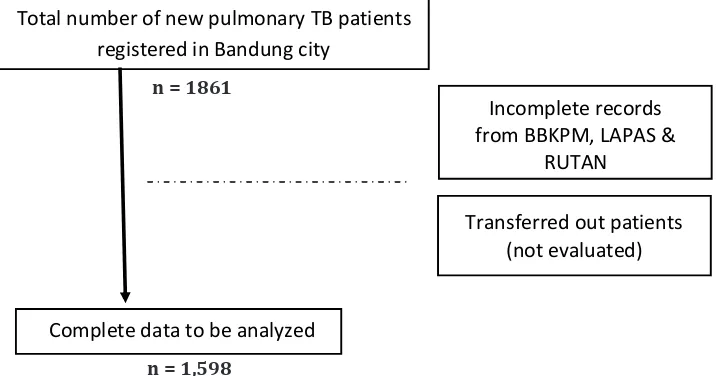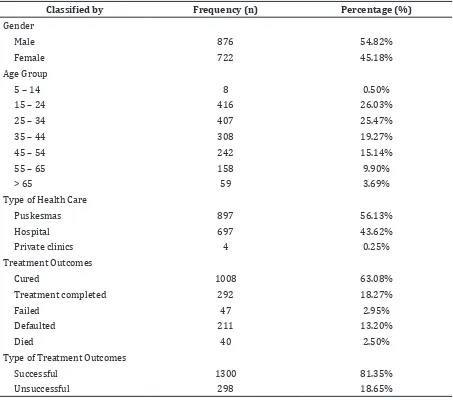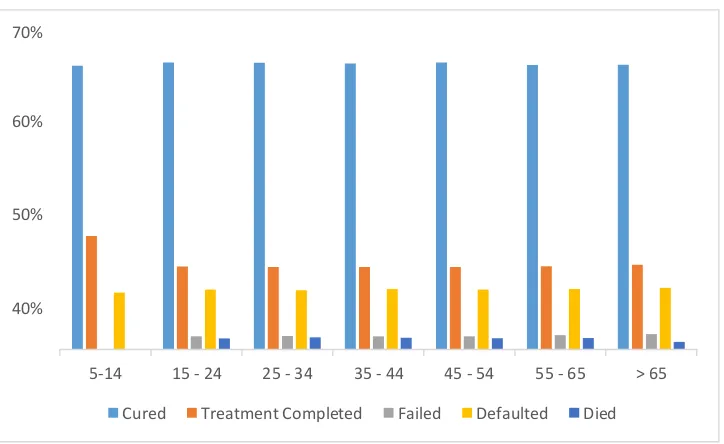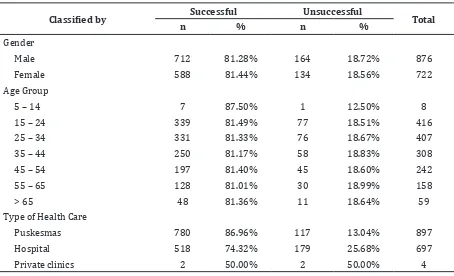Description of Treatment Outcomes among Pulmonary Tuberculosis
Patients in Bandung City in 2014
Syafinaz Hamdan,1 Enny Rohmawaty,2 Bony Wiem Lestari3
1Faculty of Medicine Universitas Padjadjaran, 2Department of Pharmacology and Therapy Faculty of Medicine Universitas Padjadjaran, 3Department of Public Health Faculty of Medicine
Universitas Padjadjaran
Abstract
Background: Pulmonary Tuberculosis (pulmonary TB) is an infectious lung disease which is still a major health problem in the world. In Indonesia, pulmonary TB treatment outcomes are monitored and assessed in Directly Observed Treatment Short Course (DOTS) as an indicator of national TB control program performance. Therefore, the study was conducted to determine the treatment outcomes among pulmonary TB patients in Bandung City.
Methods: This cross-sectional study was conducted using secondary data. The sample sizes were 1,598 pulmonary TB patients taken by total sampling with data collected from TB Registration database of Bandung city at Infectious Disease Control Unit, Bandung City Health Office (Unit Kontrol Penyakit Menular, Dinas Kesehatan Kota Bandung) from January to December 2014. The treatment outcomes were classified as successful (cured and treatment completed) and unsuccessful (failed, defaulted, and died).
Results: Out of the 1,598 TB patients, most of the respondents were male, aged 15–24 years old and from Public Health Center (Pusat Kesehatan Masyarakat, Puskesmas) and hospital. A total of 1,008 treatments (63.08%) were cured, 292 (18.27%) were completed, 47 (2.94%) were failed, 211 (13.21%) were defaulted, and 40 (2.50%) were died. Total of transferred outpatients were 134 and not considered as treatment outcome.
Conclusions: From the results, it can be concluded that 81.35% and 18.65% were considered as successful and unsuccessful outcome respectively, thus, did not achieve WHO target of 85%. Therefore, DOTS program implemented in Bandung City should be reviewed to improve success rate of the treatment outcome.
Keywords: Pulmonary tuberculosis, treatment outcome, type of healthcare
Correspondence: Syafinaz Hamdan, Faculty of Medicine, Universitas Padjadjaran, Jalan Raya Bandung-Sumedang
Km.21, Jatinangor, Sumedang, Indonesia, Email: syafinaz1906@gmail.com
Introduction
Tuberculosis (TB) is an infectious disease caused by TB bacteria (Mycobacterium tuberculosis) which is still a major health problem in the world, estimated 9.6 million new TB cases reported globally in 2014 by World Health Organization (WHO).1 According to national TB prevalence survey in Indonesia conducted from 2013 to 2014, the burden of TB disease in the country is high which per 100,000 population, an estimated incidence rate and prevalence rate of 403 and 660 has been reported.1 West Java meanwhile recorded the highest number of pulmonary TB, comprising 18% compared to other provinces in Indonesia. High TB case notification rate is also reported in 2013 by 102 per 100,000
population.2
The Directly Observed Treatment Short Course (DOTS) strategy, which allows patients to take its daily drugs under the observation of health professionals, has been adopted by the Ministry of Health of Indonesia since 1995. In its implementation, indicators such as minimum 70% of case detection rate (CDR), minimum 80% of conversion rate, and minimum 85% of cure rate have been set to monitor the achievement of the national TB control program.3 Monitoring and evaluation of treatment outcomes of TB patients are an unseparated part of DOTS strategy in TB control programs. Treatment outcomes success rate according to WHO has been standardized at 85%.1
regencies of Indonesia have reported the treatment outcomes. However, limited studies have been conducted in details for the treatment outcomes of new positive pulmonary TB patients based on sociodemographic characteristics of the patients and type of health care facilities involved. Therefore, specific interest has been taken in count to study the treatment outcomes among pulmonary TB patients of Bandung city in 2014 based on gender, age group, and type of health care facilities.
Methods
This cross-sectional study was conducted using secondary data from TB Registration database of Bandung city from January to December 2014. This study was conducted at Infectious Disease Control Unit, Bandung City Health Office (Unit Kontrol Penyakit Menular, Dinas Kesehatan Kota Bandung). Populations in this study were all TB patients registered in TB Registration database in Bandung city. This study used total sampling technique to select 1,861 new pulmonary TB patients who were treated and registered in the database from January to December 2014. The inclusion criteria were registered TB patients aged ≥ 5 years old diagnosed as having pulmonary TB who got treatment from Public Health Center (Pusat Kesehatan Masyarakat, Puskesmas), hospital, and private clinics. The exclusion criteria would be the incomplete records, which were data from Community Lung Health Center (Balai Besar Kesehatan Paru
Masyarakat, BBKPM) Bandung, Correctional Facility (Lembaga Pemasyarakatan, LAPAS), and Detention House (Rumah Tahanan, RUTAN). In this study, patients who were not evaluated or out of category in which TB patients without treatment outcomes were assigned as excluded from the treatment outcomes. Hence, total sample of 1,598 new pulmonary TB patients were evaluated. Figure 1 provided summary for the research subjects selection.
Variable of this study was the treatment outcomes that were classified into cured, treatment completed, failed, defaulted, and died in accordance with Pedoman Nasional Pengendalian Tuberkulosis, Kementerian Kesehatan Republik Indonesia, 2014.3 These were analyzed using descriptive analysis. Treatment outcomes were further evaluated as categorical data as gender, age group, and type of health care facilities and presented as total number and percentage. Gender was categorized as male and female. Age group of patients were divided into; 5–14, 15–24, 25– 34, 35– 44, 45–54, 55–65, and ˃65. This study has been approved by Health Research Ethics Committee, Faculty of Medicine, Universitas Padjadjaran (No: 919/UN6.C1.3.2/KEPK/ PN/2016).
Results
A total of 1,598 pulmonary TB patients data recorded from January to December 2014 were analyzed. Table 1 shows patients characteristics classified into gender, age
Figure 1 Summary of Research Subjects Selection
Total number of new pulmonary TB patients registered in Bandung city
Incomplete records from BBKPM, LAPAS &
RUTAN
Transferred out patients (not evaluated)
Complete data to be analyzed
n = 1861
Table 1 Distribution of Pulmonary TB Patients based on Gender, Age Group, Type of Health Care, and Treatment Outcomes (n = 1,598)
Classified by Frequency (n) Percentage (%)
Gender
Male 876 54.82%
Female 722 45.18%
Age Group
5 – 14 8 0.50%
15 – 24 416 26.03%
25 – 34 407 25.47%
35 – 44 308 19.27%
45 – 54 242 15.14%
55 – 65 158 9.90%
> 65 59 3.69%
Type of Health Care
Puskesmas 897 56.13%
Hospital 697 43.62%
Private clinics 4 0.25%
Treatment Outcomes
Cured 1008 63.08%
Treatment completed 292 18.27%
Failed 47 2.95%
Defaulted 211 13.20%
Died 40 2.50%
Type of Treatment Outcomes
Successful 1300 81.35%
Unsuccessful 298 18.65%
outcomes.
Discussions
In this study, TB treatment success rate among new positive Pulmonary TB patients was 81.35%. This was less than the treatment success rate target set by WHO.1 In 2014, national TB control program targeted the number of defaulted outcomes to be less than 5%.4 In this study, however, unsuccessful treatment outcomes were mostly from defaulted treatment amounted 211 (13.20%). This is somewhat comparable to the results of studies from Cameroon5 (20%), Libya6 (28%) and Singapore7 (9%). This study also showed defaulted treatment was slightly higher in male, 117 (7.32%) compared to female, 94 group, and type of health care facilities from
which they have been getting treatment and treatment outcomes.
Figure 2 shows TB treatment outcomes based on gender. There were 876 (54.82%) male patients, dominated subjects in this study. Figure 3 describes that more than 60% of patients for every age group were fully cured.
(5.88%).
Majority of the patients in this study were male, 876 (54.81%) similar to a study in Western Ethiopia8 which reported 54.5% of the patients are male. This might be due to men spent more money in accessing care than women which is related to their ability to pay.9 Females are described to be less likely to visit health care facilities (health post, clinic, public health center, and hospitals) than males.10
Several studies also showed that risk of pulmonary TB is greater in males than in females. This might be due to higher proportion of males carrying out more activities than females, thus, being exposed to the infection area is greater in males.11,12 Smoking behavior in males meanwhile could lower the immune system and increase the risk for relapse case of pulmonary TB.13 In this study, treatment success rate for females (81.44%) were slightly
Figure 2 Treatment Outcomes based on Gender
Figure 3 Treatment Outcomes based on Age Group
70%
60%
50%
40%
Cured Treatment
Completed
Failed Defaulted Died
Male Female
70%
60%
50%
40%
5-14 15 - 24 25 - 34 35 - 44 45 - 54 55 - 65 > 65
higher than that for males (81.28%). Although there is no difference in the result, other studies found that smokers, especially males smokers, are less adherent to anti-tuberculosis treatment, and therefore, at higher risk for poor treatment outcomes.14 Likewise, a study in South Korean15 (2009) stated that there is
an increased risk of TB incident associated with smoking behavior in which male smokers have an approximately 50% increase in risk.
In this study, 85.91% of the registered new TB patients were included in the age range of productive age group between 15–54 years as shown in Table 1, which is
Figure 4 Treatment Outcomes based on Type of Facilities
70%
60%
50%
40%
Puskesmas Hospital Private Clinics
Cured Treatment Completed Failed Defaulted Died
Table 2 Overall TB Treatment Outcomes of Pulmonary TB (n = 1,598)
Classified by Successful Unsuccessful Total
n % n %
Gender
Male 712 81.28% 164 18.72% 876
Female 588 81.44% 134 18.56% 722
Age Group
5 – 14 7 87.50% 1 12.50% 8
15 – 24 339 81.49% 77 18.51% 416
25 – 34 331 81.33% 76 18.67% 407
35 – 44 250 81.17% 58 18.83% 308
45 – 54 197 81.40% 45 18.60% 242
55 – 65 128 81.01% 30 18.99% 158
> 65 48 81.36% 11 18.64% 59
Type of Health Care
Puskesmas 780 86.96% 117 13.04% 897
Hospital 518 74.32% 179 25.68% 697
similar to studies from Southern Ethiopia16, Malaysia17, and Ethiopia.18 Non productive age group around above 50 years old is usually more complicated in TB treatment due to medication of other systemic diseases causing increased side effects, increased re-treatment cases, and resistance to anti-tuberculosis drug. This might be due to reduced absorption of drug related with physiological changes in the body as age increases and strength to fight infections decreases.19
This study also revealed the number of registered TB patients based on type of health care facilities consisting of Puskesmas, hospitals, and private clinics. More than half of the patients, 897 (56.13%) were getting treatment from Puskesmas, followed by hospitals, 697 (43.62%). In Indonesia, the government has set the policy for Puskesmas to be the primary healthcare service to the society, thus, making it more accessible to every districts and sub-districts and economically affordable.2
Table 2 showed that 86.96% of successful treatment was from Puskesmas compared to 74.32% recorded from hospitals. Also, there were only 13.04% unsuccessful treatment outcomes from Puskesmas compared to that from hospital of 25.68%. This clearly showed that TB treatment program in Puskesmas was more efficient than that in hospital. National TB Control Strategy in Indonesia 2010–2014 reported that the number of TB drug resistance in patients treated in health care facilities was generally still low. However, most of the data were obtained from Puskesmas which implemented proper DOTS strategy in the last five years. This is because probability of the occurrence of TB drug resistance is higher in hospitals and in private sector who have not been engaged in national TB control programs due to high level of non-compliance and drop out treatment for not implementing the DOTS strategy.20 It was also reported that about 98% of staff in Puskesmas are well-trained with TB control program compared to 24% of hospital staff.4
Successful treatment outcomes among pulmonary TB patients in Bandung city in 2014 are 81.35%. Comparably (78.5%) successful outcomes have been reported from Malaysia17 while other studies from Addis Ababa, Ethiopia18 also reported treatment success rate of 82.7%. This is somehow still below the standard set by WHO which is 85%. The possible reason behind this problem is decentralized health care facilities that negatively affect human resource capacity
and development of TB control programs. Factors such as limited number of staff, rotation of staff, and continuity between training programs are among the challenges in human resource development. Monitoring and evaluation also should be done through supervision activities at various levels. However, due to lack of resources (human resource, finance, and logistic), supervision is not carried out regularly. Besides, limitation of access to the quality service of DOTS are also found especially in population of economically unaffordable society in urban areas.4
The limitation of this study is the limited number of variables obtained from the database. Information on other factors such as education level, place of residence, smoking, occupational status, chronic disease, and other sociocultural factors that could also affect the treatment outcome was not available in the register. This study is also dependent on secondary data collected from the database, and any error or incompletion during the data entry process cannot be detected. Suggestion for the next study is to explore the factors that can affect the treatment outcomes with a bigger population and a longer study period. This shall yield a better trend of outcomes and shall give more input of the pattern of the TB treatments.
By knowing the treatment outcomes, it shows that pulmonary TB is still a serious public health concern that needs to be addressed urgently in Bandung city. To improve treatment outcome of tuberculosis patients, improved and systematically implementation of supervision and monitoring the clinical improvement of patients with risk factors should be done to increase the cure rate. Similarly, forceful effort in following up the treatment defaulters and transferred out patients should be done and health education are also recommended to reduce unfavorable treatment outcomes.
References
1. WHO. Global tuberculosis report 2015. 20th ed. Geneva: WHO Press; 2015.
2. Kementerian Kesehatan Republik Indonesia. Laporan kinerja triwulan III Direktorat Jenderal Pencegahan dan Pengendalian Penyakit. Jakarta: Kementerian Kesehatan Republik Indonesia; 2013.
Direktorat Jenderal P2PL (Pengendalian penyakit dan penyehatan lingkungan); 2014.
4. Kementerian Kesehatan Republik Indonesia. Strategi nasional pengendalian tuberkulosis di Indonesia 2010-2014. Jakarta: Direktorat Jenderal Pengendalian Penyakit dan Penyehatan Lingkunga; 2011. 5. Pefura Yone EW, Kuaban C, Kengne AP.
HIV testing, HIV status and outcomes of treatment for tuberculosis in a major diagnosis and treatment centre in Yaounde, Cameroon: a retrospective cohort study. BMC Infect Dis. 2012;12:190–7.
6. Solliman MA, Hassali MA, Al-Haddad MS, Sulaiman SAS, Shafie AA, Atif M, et al. Treatment outcomes of new smear positive pulmonary tuberculosis patients in north east Libya. Lat Am J Pharm. 2012;31(4):567–73.
7. Chee CB, Wang YT, Teleman MD, Boudville IC, Chew SK. Treatment outcome of Singapore residents with pulmonary tuberculosis in the first year after introduction of a computerised treatment surveillance module. Singapore Med J. 2006;47(6):529–33.
8. Demeke D, Legesse M, Bati J. Trend of tuberculosis and treatment outcomes in gambella region with special emphasize on Gambella Regional Hospital, Western Ethiopia. J Mycobac Dis. 2013;3(2):130. 9. Aspler A, Menzies D, Oxlade O, Banda J,
Mwenge L, Godfrey-Faussett P, et al. Cost of tuberculosis diagnosis and treatment from the patient perspective in Lusaka, Zambia. Int J Tuberc Lung Dis, 2008;12(8):928–35. 10. Yimer S, Holm-Hansen C, Yimaldu T, Bjune
G. Health care seeking among pulmonary tuberculosis suspects and patients in rural Ethiopia: a community-based study. BMC Public Health,. 2009;9(1):454–63.
11. Somma D, Thomas BE, Karim F, Kemp J, Arias N, Auer C, et al. Gender and sociocultural determinants of TB-related stigma in Bangladesh, India, Malawi and Colombia. Int J Tuberc Lung Dis.2008;12(7):856–66.
12. Karim F, Ahmed F, Begum I, Johansson E, Diwan VK. Female-male differences at various clinical steps of tuberculosis management in rural Bangladesh. Int J Tuberc Lung Dis. 2008;12(11):1336–9. 13. Ng N, Padmawati RS, Prabandari YS,
Nichter M. Smoking behavior among former tuberculosis patients in Indonesia: intervention is needed. Int J Tuberc Lung Dis. 2008;12(5):567–72.
14. Lavigne M, Rocher I, Steensma C, Brassard P. The impact of smoking on adherence to treatment for latent tuberculosis infection. BMC Public Health. 2006;6:66.
15. Jee SH, Golub JE, Jo J, Park IS, Ohrr H, Samet JM. Smoking and risk of tuberculosis incidence, mortality, and recurrence in South Korean men and women. Am J Epidemiol. 2009;170(12):1478–85.
16. Gebrezgabiher G, Romha G, Ejeta E, Asebe G, Zemene E, Ameni G. Treatment outcome of tuberculosis patients under directly observed treatment short course and factors affecting outcome in Southern Ethiopia: a five-year retrospective study. PlOS one. 2016;11(2):e0150560.
17. Liew S, Khoo E, Ho B, Lee Y, Mimi O, Fazlina M, et al. Tuberculosis in Malaysia: predictors of treatment outcomes in a national registry. Int J Tuberc Lung Dis. 2015;19(7):764–71.
18. Getahun B, Amani G, Medhin G, Biadgilign S. Treatment outcome of tuberculosis patients under directly observed treatment in Addis Ababa, Ethiopia. Brazilian J Infect Dis. 2013;17(5):521–8.
19. Puspasari N. Karakteristik pasien tuberkulosis yang memperoleh pengobatan kategori 2 di UP4 Provinsi Kalimantan Barat tahun 2009-2012. Jurnal Mahasiswa PSPD FK Universitas Tanjungpura. 2014;1(1):1–28.



